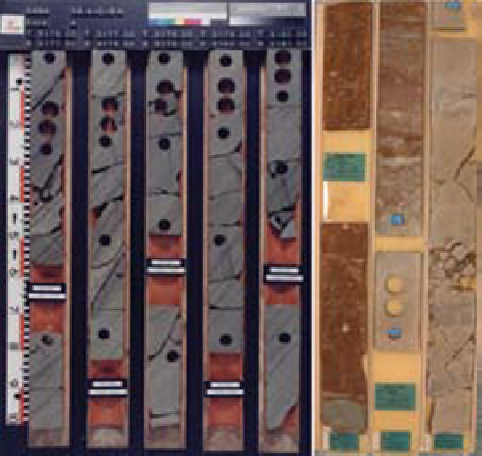Geoscience Reference
In-Depth Information
The braided stream channel deposits of FSA1
probably formed during violent ephemeral flash-
flood events, since their facies range and associa-
tion with reddish-brown mudstones indicates an
arid to semi-arid climate.
34/4-C-6H
240 40
0.45 NPHI -0.15
DT
0
GR
CALI
120
6
16
1.95 RHOB 2.95
Clay Si
Sand
30
Fluvial sandstone assemblage 2 (FSA2) - braided
to meandering streams
Braided stream
channel belts
40
The fluvial sandstone assemblage 2 (FSA2), seen
only in the middle part of the Lunde Formation
(L09 to L06), shows approximately equal amounts
(40%) of channel deposits and floodplain fines,
with approximately 20% to 25% crevasse splay
sandstones (Figs 3, 4 and 7). Unlike the underly-
ing allostratigraphic units with FSA1, the channel
L11
3350
60
Braided stream
channel belts
70
80
Braided stream
channel belts
90
Braided stream
channel belt
3400
L12
10
20
Fig. 5.
Core photographs of representative alluvial facies of
the Lunde Formation. To the left, braided stream sandstone
bodies with typical bedsets of trough cross-stratified, low-
angle-stratified and parallel-stratified sandstone, from the
lower part of the Lunde Formation, well 34/4-C-6H. To the
right, the upper part of a point bar sandstone with
intercalations of mudstone, passing upwards into overlying
floodplain mudstone with palaeosol, upper part of the
Lunde Formation, well 34/4-9S.
Braided stream
channel belts
30
40
Braided stream
channel belt
3450
Fig. 6.
Sedimentary log from well 34/4-C-6H, Snorre Field,
showing characteristic stratigraphic organisation of fluvial
sandstone assemblage FSA1 in the lower part of the Lunde
Formation (LLF). Channel sandstone bodies are interpreted
to have been deposited by ephemeral braided streams.
Gr = Gamma ray, CALIP = Caliper, DT = Velocity, NPHI =
Neutron porosity, RHOB = Density.
Alke
Clay Si
Sand
Channel deposits
Crevasse splay/channel deposits
Floodplain deposits, red





Search WWH ::

Custom Search